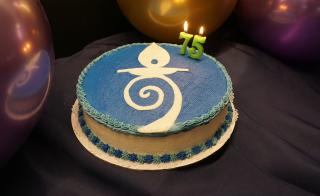Advertisement
On March 12, 1944, Private Raymond A. Young penned a deeply personal letter addressed simply to “Gentlemen” at the American Unitarian Association in Boston. A Unitarian stationed at Fort Monmouth in New Jersey, Young sought sermons that might prepare him to go to war and comfort his family should he not return:
I am wondering if any of the minister[s] has given any sermon or lecture that [would help me] believe that all this sacrifice . . . will not be as fruitless as it was the last time and particularly . . . to show my wife that all will not have been in vain should she and my daughter lose me.
Days later, AUA staff member Florence Baer replied to Young’s letter, describing a new AUA project: “For just such people as yourselves who are interested in the Unitarian movement but who are not now located [near] a Unitarian church, we are forming ‘The Church of the Larger Fellowship.’”
Later that year, the Unitarian Church of the Larger Fellowship, or UCLF, was established, though the strands of its history extend a century earlier, to the western expansion of Unitarianism and the AUA’s founding in 1825. Its history is closely intertwined with the fellowship movement and the growth of Unitarian Universalism in the mid-twentieth century.
This year marks the 75th anniversary of what is now known simply as the Church of the Larger Fellowship (CLF), the UUA’s largest congregation, with a membership of 2,521 and a unique mission to serve its members and to share the “good news” of Unitarian Universalism around the world.
In CLF: A Study in Liberal Religious Prospecting, the Rev. Laura Cavicchio traces CLF’s lineage in the Unitarian and Universalist traditions and in missionary projects like the “Pamphlet Mission” and “Post Office Mission” of the Western Unitarian Conference. The church-by-mail efforts of this period were largely carried out by laypeople like Sallie Ellis of Cincinnati, Ohio, who from 1877 until her death a few years later was the driving force behind “the Post Office Mission,” which spread liberal faith and was an influential model, replicated by churches in the United States and abroad.
UCLF’s initial charge was “to provide a spiritual home for isolated Unitarians and their families and to transfer the allegiance of its members to local Unitarian churches whenever and wherever possible.” Over time, the idea of CLF as a lost-and-found for displaced Unitarians evolved to that of a distinct congregation—of necessity for some, of choice for others. It served as a resource for fellowships, and as a global representative of the faith.
“CLF [was] very important in the ’40s and ’50s in the fellowship movement,” says the Rev. Dr. O. Eugene Pickett, former UUA president and CLF minister from 1986 to 1991. “After the war, it was the way that Unitarian Universalism expanded and grew, through the development of fellowships [and] small lay-led groups.” Munroe Husbands, an AUA staff member and UCLF clerk at that time, helped establish more than 400 fellowships during this period, often starting with a core of CLF members.
Every CLF minister has ushered in innovations. The Rev. Dr. George Marshall created the Independent Study Program; Pickett and his team produced “Church in a Box,” for small fellowships; the Rev. Scott Alexander established a “minister’s 800 line”; and the Rev. Jane Rzepka brought CLF online with a website, listservs, and a digital version of its newsletter, Quest. Today, the Rev. Meg Riley and colleagues lead weekly worship at CLF’s YouTube channel. Their motto, “Always in beta,” is fitting for a community that pushes both spiritual and technological boundaries.
Like every large congregation, says Riley, CLF contains many “parallel universes.” Members live across the United States, Canada, and abroad; some key constituencies include ministers and other religious leaders and their families, and UU military chaplains, for whom CLF serves as a home base. CLF’s prison ministry serves nearly 1,000 members who are incarcerated and educates UUs about prison ministry and reform.
CLF staff connect with congregants on paper, over email, in video conferences, through online worship, in Facebook covenant groups, and through CLF’s weekly YouTube talk show, The VUU. While online platforms can’t replace in-person interactions, Riley believes they can foster profound connections and create “a place of grace” in the digital world. “There’s a vulnerability people sometimes are willing to share [online] that they wouldn’t in the pews,” allowing for “a ministry that’s both distant but also acutely personal.”
Lena K. Gardner, executive director of Black Lives of Unitarian Universalism (BLUU) and a former CLF staff member, notes that CLF has provided key support for BLUU’s formation and ministry. In a recent survey of BLUU constituents, Gardner says that many respondents reported leaving UU “brick-and-mortar congregation[s] because of white supremacy and the way that whiteness operates in those spaces,” but have found in CLF a congregation where they can “show up as more of their full selves.” While many congregations seem to resist the changes inherent in racial justice ministry, Gardner feels that CLF is doing “a standout job of listening [to] and celebrating [black] leadership” within the movement.
Among the most vital additions to CLF in recent years are the Learning Fellows, whose work expands CLF’s capacity and the UU ministry. Riley calls them “the heart and soul of CLF,” bringing “passion for a different kind of ministry, and wild curiosity about how to augment brick-and-mortar ministry.”
Seventy-five years in, CLF remains an ongoing work of spirit and imagination, where some of the faith’s oldest traditions co-exist with boundary-breaking experiments. Like the postal missions from which it grew, CLF amplifies the voices and message of the faith in the world and offers a spiritual home where everyone is always welcome. It’s like the Motel 6 slogan, says Riley: “We’ll leave the light on for you.”
